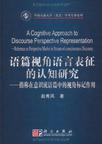语篇视角语言表征的认知研究
出版时间:2009-4 出版社:科学出版社 作者:赵秀凤 页数:286
前言
大学是以追求和传播真理为目的,并为社会文明进步和人类素质提高产生重要影响力和推动力的教育机构和学术组织。1953年,为适应国民经济和石油工业发展需求,北京石油学院在清华大学石油系并吸收北京大学、天津大学等院校力量的基础上创立,成为新中国第一所石油高等院校。1960年成为全国重点大学。历经1969年迁校山东改称华东石油学院,1981年又在北京办学,数次搬迁,几易其名。在半个多世纪的历史征程中,几代“石大”人秉承追求真理、实事求是的科学精神,在曲折中奋进,在奋进中实现了一次次跨跃。目前,学校已成为石油特色鲜明、以工为主、多学科协调发展的“211工程”建设的全国重点大学。2006年12月,学校进入“国家优势学科创新平台”高校行列。 学校在发展历程中,有着深厚的学术记忆。学术记忆是一种历史的责任,也是人类科学技术发展的坐标。许多专家学者把智慧的涓涓细流,汇聚到人类学术发展的历史长河之中。据学校的史料记载:1953年建校之初,在专业课中有90%的课程采用前苏联等国的教材和学术研究成果。广大教师不断消化吸收国外先进技术,并深入石油厂矿进行学术探索。到1956年,编辑整理出学术研究成果和教学用书65种。1956年4月,北京石油学院第一次科学报告会成功召开,活跃了全院的学术气氛。1957~1966年,由于受到全国形势的影响,学校的学术研究在曲折中前进。然而许多教师继续深入石油生产第一线,进行技术革新和科学研究。到1964年,学院的科研条件逐渐改善,学术研究成果以及译著得到出版。党的十一届三中全会之后,科学研究被提到应有的中心位置,学术交流活动也日趋活跃,同时社会科学研究成果也在逐年增多。自1986年,学校设立科研基金,学术探索的氛围更加浓厚。学校始终以国家战略需求为使命。进入“十一五”之后,学校科学研究继续走“产学研相结合”的道路,尤其重视基础和应用基础研究。“十五”以来学校的科研实力和学术水平明显提高,成为石油与石化工业的应用基础理论研究和超前储备技术研究以及科技信息和学术交流的主要基地。
内容概要
《语篇视角语言表征的认知研究:指称在意识流语篇中的视角标记作用》立足于语篇,结合认知语言学理论和叙事语篇的语类特征,对语篇视角化的不同语言表征提出一个统一的理论阐释,扩大了研究范畴,加深了对这一现象的理解,《语篇视角语言表征的认知研究:指称在意识流语篇中的视角标记作用》的认知语言学研究视角对文学教学具有指导意义,有利于提高对复杂叙事语篇(如意识流)语篇的解读和赏析能力,培养相应的阅读策略。
作者简介
赵秀凤,山东济阳人,1986年考入山东大学外语系。1993年毕业于山东大学,获文学硕士学位。2003年~2006年在北京师范大学深造,获英语语言文学博士学位,师从田贵森教授。1993年至今执教于中国石油大学(北京)外语系,现为外语系副主任、教授、硕士生导师。1998年8月~1999年2月在美国怀俄明大学做访问学者。2001年4月~2002年4月,在日本福井县做国际交流员。 曾先后在《外语学刊》、《外语教学》、《解放军外国语学院学报》、《四川外语学院学报》等外语类核心期刊和外语界专业期刊发表学术论文20余篇,并主编或参编教材、译著多部。研究方向:认知语言学、文体学、语篇分析。
书籍目录
丛书序序自序Chapter 1 Introduction1.1 Discourse perspective1.2 Discourse perspective representation1.3 Discourse perspective representation in stream-of-consciousness fiction1.4 Reference1.5 Objectives of this study1.6 Data and methodology1.7 Organization of the bookChapter 2 Previous Researches on Discourse Perspective Representation2.1 Approaches to discourse perspective representation2.1.1 Formalistic approaches2.1.2 Functional approaches2.1.3 Cognitive approaches2.2 Cognitive studies on reference2.2.1 Langacker: epistemic footing of reference2.2.2 Fauconnier: accessible space of reference2.2.3 Ariel: addressee-oriented accessibility2.2.4 Chafe: protagonist-oriented accessibility2.2.5 Li & Zubin: discourse continuity and perspective taking2.3 SummaryChapter 3 A Cognitive Model to Discourse Perspective Representation3.1 Theoretical foundations3.1.1 Preliminary assumptions3.1.2 Mental Space Theory: DPR as mental space configuration3.1.3 Ground and viewing arrangement: DPR as ground configuration3.2 A cognitive model to DPR construction3.2.1 Preliminaries to DPR construction3.2.2 A ground-based model3.3 Specific illustrations to the model3.3.1 Categorization of the representational modes3.3.2 Expressive/reportive representation3.3.3 Motivations for ground configuration3.4 SummaryChapter 4 Ground Alignment and Reference to the Experiencer4.1 Grounding nature of referring expressions4.1.1 Components of referring expressions4.1.2 Grounding and coding the experiencer4.2 G-alignment and reference to the experiencer4.2.1 Coded as full NPs4.2.2 Coded as reduced NPs4.3 G-alignment and reference to the experiencer4.3.1 Non-overt code for maximal subjectivity4.3.2 Coded as first person pronouns4.3.3 Coded as second person pronouns4.3.4 Coded as third person NPs4.3.5 Summary: mental model of reality and self-reference4.4 Blend alignment and third person reflexives4.4.1 Cognitive structure of reflexives4.4.2 Coded as unbound reflexives4.4.3 Coded as long-distance bound reflexives4.5 Degree of objectification and self-referring expressions4.6 SummaryChapter 5 Ground Alignment and Reference to the Experienced Object5.1 Preliminaries on reference to the experienced object5.1.1 Relevant issues5.1.2 Ground configurations for reference to the experienced in general5.2 G-alignment and reference to the experienced object5.2.1 Schematic reference from omnipresence for detachment5.2.2 Transparent reference from omniscience for unified reportiveness5.3 G-alignment and reference to the experienced object5.3.1 Non-basic categorized reference for expressiveness5.3.2 (In)definite reference for expressiveness5.3.3 Perspectivized reference for displaced expressivity5.4 Co-alignment and reference to the experienced object5.4.1 Metaphorical reference for dramatization5.4.2 Opaque reference for the tinge of expressiveness5.5 SummaryChapter 6 Ground Configuration and Reference Distribution6.1 Ground-based accessibility6.1.1 Epistemic nature of grounding6.1.2 Access path in space configurations6.1.3 A model of ground-based accessibility6.2 Distribution of reference to the experiencer6.2.1 Suppressed reference to the experiencer6.2.2 Reference distribution in discourses with parentheticals6.3 Distribution of reference to the experienced object6.3.1 Marked pronominal reference for immediacy6.3.2 Marked nominal reference for detachment6.4 Ground confgurafion and categorical reference interaction6.4.1 Local reference coordination and degree of expressiveness6.4.2 Global reference distribution and ground shifts6.5 The interplay of reference and other devices in DPR categorization...6.6 SummaryChapter 7 Conclusion7.1 Summary7.2 Limitations and implicationsBibliographyAppendixList of TablesTable 3.1 DPR components in fictional narrative discourseTable 3.2 Parameters of ground configurationTable 4.1 References to self and others (we, us, our) in Samples from UlyssesTable 4.2 Occurrence of LDB and unbound ziji (自己) in SOC fictionTable 4.3 Occurrence of LDB and unbound English reflexives in SOC fictionTable 4.4 References to Self in sampled passages from UlyssesTable 6.1 Correlation between references and degree of expressiveness/reportivenessTable 6.2 Correlations among ground alignment, space configuration and expressiveness
章节摘录
And its central notion of "Mental Space" integrates diverse models proposed in discourse studies such as Johnson-Lairds Mental Model (1983), Werths Text World (1999), Dinsmores Partitioned Mental Representation (1991), Emmotts Contextual Framing (1997) and van Dijks Situation Model (1983). Unifying them into mental space configuration, Fauconnier provides illuminating account for many language phenomena by demystifying the mental operations in the process of discourse production and comprehension. Acknowleged as a big step to bridge the gap between cognitive linguistics and discourse analysis, Mental Space Theory is justifiably expected to provide insightful account for a discourse-based cognitive analysis over discourse perspective representation in the context of a given discourse type, for instance, in SOC fiction. ……
编辑推荐
《语篇视角语言表征的认知研究:指称在意识流语篇中的视角标记作用》共分7章,主要包括研究背景、模式建构和实证分析几部分内容。语篇视角的表达方式与语篇体裁的特征有关,《语篇视角语言表征的认知研究:指称在意识流语篇中的视角标记作用》选择意识流语篇为典型语类,考察指称在该类语篇中的视角标识作用。通过对不同构形操作下的指称形式进行分析,总结归纳视角化程度较高的语篇中指称语的规律。通过分析指称形式在长语篇中的分布特征,发现标记性指称形式,并利用提出的认知构建模式加以阐释,能够从宏观上把握语篇视角的动态变化轨迹,区别叙事语段和视角化语段。
图书封面
评论、评分、阅读与下载
用户评论 (总计0条)
相关图书
- 数字信息服务系统的比较研究
- 网络计划管理中的机动时间特性理论及其应用
- 油气藏工程原理
- 思想道德修养与法律基础(修订版 赵兴宏 带配套CAI课件)
- H思想品德7下
- H思想品德8下
- I历史7上
- 痕迹检验教程
- D(指)新版中小学生安全教育读本6年级
- D历史9全(配人教)/天府中考全程总复习
- H青海省藏族小学汉语会话10
- F新课标藏语文8下/同步练习册
- 装配工安全技术VCD
- 巧用3000词
- 图解景观植物设计.乔木
- 图解景观植物设计灌木
- 半导体制造与过程控制基础
- 过程控制系统的MATLAB仿真
- 德国设计图典
- 实用机械加工工艺手册
- 图解景观植物设计·花卉
- 710分高分攻略
- 典型塑料模具设计图集
- 彩电维修一线资料速查速用
- 风力机控制系统原理、建模及增益调度设计
